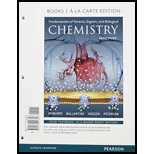
Concept explainers
(a)
Interpretation:
The given structure is whether antihistamine or antidepressant has to be predicted.
Concept Introduction:
Drugs: Drugs are molecules which are taken from an external source to change the normal functioning of the body. The action of drug is in molecular level and the design of many drugs are in such a way that it mimics a particular neurotransmitter or hormone. Drugs bind with receptors showing an increased or decreased effect.
There are two types of drugs and they are agonist and antagonist.
Histamine: Histamines are the neurotransmitters which is responsible for causing symptoms of allergic reactions. The amino acid histidine undergoes decarboxylation reaction to produce histidine.
Antihistamines: Antihistamines are antagonist of the histamine receptors. They are the family of drugs which counteract the effects caused by histamine. Antihistamine has a general structure

(a)
Interpretation:
The given structure is whether antihistamine or antidepressant has to be predicted.
Concept Introduction:
Drugs: Drugs are molecules which are taken from an external source to change the normal functioning of the body. The action of drug is in molecular level and the design of many drugs are in such a way that it mimics a particular neurotransmitter or hormone. Drugs bind with receptors showing an increased or decreased effect.
There are two types of drugs and they are agonist and antagonist.
The deficiency of the neurotransmitters serotonin, norepinephrine and dopamine leads to depression.
By the mode of action, three families of drugs are used as effective anti-depressant. They are,
- 1. Tricyclic antidepressant (Elavil): It prevents the reabsorption of serotonin and norepinephrine from the inside of synapse
- 2. Monoamine oxidase (MAO) inhibitor (Nardil): It prevents the enzyme which breaks down serotonin, norepinephrine and dopamine
- 3. Selective serotonin re-uptake inhibitors, SSRI (Prozac): It prevents the reabsorption of serotonin alone
Want to see the full answer?
Check out a sample textbook solution
Chapter 28 Solutions
Fundamentals of General, Organic, and Biological Chemistry, Books a la Carte Plus Mastering Chemistry with Pearson eText -- Access Card Package (8th Edition)
- Which type of enzyme catalyses the following reaction? oxidoreductase, transferase, hydrolase, lyase, isomerase, or ligase.arrow_forward+NH+ CO₂ +P H₂N + ATP H₂N NH₂ +ADParrow_forwardWhich type of enzyme catalyses the following reaction? oxidoreductase, transferase, hydrolase, lyase, isomerase, or ligase.arrow_forward
- Which features of the curves in Figure 30-2 indicates that the enzyme is not consumed in the overall reaction? ES is lower in energy that E + S and EP is lower in energy than E + P. What does this tell you about the stability of ES versus E + S and EP versus E + P.arrow_forwardLooking at the figure 30-5 what intermolecular forces are present between the substrate and the enzyme and the substrate and cofactors.arrow_forwardprovide short answers to the followings Urgent!arrow_forward
- Pyruvate is accepted into the TCA cycle by a “feeder” reaction using the pyruvatedehydrogenase complex, resulting in acetyl-CoA and CO2. Provide a full mechanismfor this reaction utilizing the TPP cofactor. Include the roles of all cofactors.arrow_forwardB- Vitamins are converted readily into important metabolic cofactors. Deficiency inany one of them has serious side effects. a. The disease beriberi results from a vitamin B 1 (Thiamine) deficiency and ischaracterized by cardiac and neurological symptoms. One key diagnostic forthis disease is an increased level of pyruvate and α-ketoglutarate in thebloodstream. How does this vitamin deficiency lead to increased serumlevels of these factors? b. What would you expect the effect on the TCA intermediates for a patientsuffering from vitamin B 5 deficiency? c. What would you expect the effect on the TCA intermediates for a patientsuffering from vitamin B 2 /B 3 deficiency?arrow_forwardDraw the Krebs Cycle and show the entry points for the amino acids Alanine,Glutamic Acid, Asparagine, and Valine into the Krebs Cycle - (Draw the Mechanism). How many rounds of Krebs will be required to waste all Carbons of Glutamic Acidas CO2?arrow_forward
- Essentials of Pharmacology for Health ProfessionsNursingISBN:9781305441620Author:WOODROWPublisher:Cengage
 Comprehensive Medical Assisting: Administrative a...NursingISBN:9781305964792Author:Wilburta Q. Lindh, Carol D. Tamparo, Barbara M. Dahl, Julie Morris, Cindy CorreaPublisher:Cengage Learning
Comprehensive Medical Assisting: Administrative a...NursingISBN:9781305964792Author:Wilburta Q. Lindh, Carol D. Tamparo, Barbara M. Dahl, Julie Morris, Cindy CorreaPublisher:Cengage Learning  Human Physiology: From Cells to Systems (MindTap ...BiologyISBN:9781285866932Author:Lauralee SherwoodPublisher:Cengage Learning
Human Physiology: From Cells to Systems (MindTap ...BiologyISBN:9781285866932Author:Lauralee SherwoodPublisher:Cengage Learning Biology: The Unity and Diversity of Life (MindTap...BiologyISBN:9781305073951Author:Cecie Starr, Ralph Taggart, Christine Evers, Lisa StarrPublisher:Cengage Learning
Biology: The Unity and Diversity of Life (MindTap...BiologyISBN:9781305073951Author:Cecie Starr, Ralph Taggart, Christine Evers, Lisa StarrPublisher:Cengage Learning Medical Terminology for Health Professions, Spira...Health & NutritionISBN:9781305634350Author:Ann Ehrlich, Carol L. Schroeder, Laura Ehrlich, Katrina A. SchroederPublisher:Cengage Learning
Medical Terminology for Health Professions, Spira...Health & NutritionISBN:9781305634350Author:Ann Ehrlich, Carol L. Schroeder, Laura Ehrlich, Katrina A. SchroederPublisher:Cengage Learning





